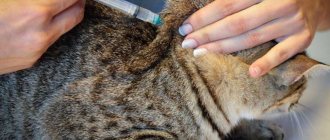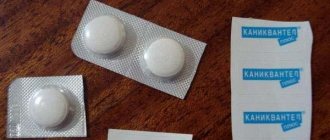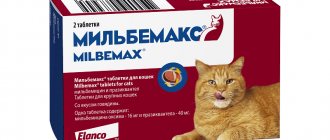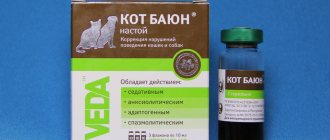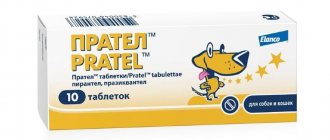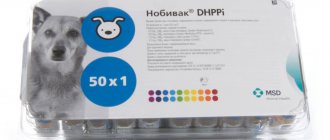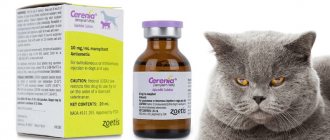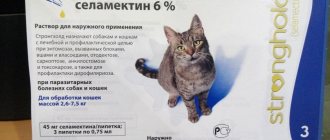7137Pavel
Unfortunately, stomach or intestinal disorders are not at all uncommon for kittens. In such a situation, you need to help the baby as soon as possible, because it is important to avoid dehydration and other possible complications. But how to give Smecta to a kitten? What should be the dosage, and in what cases should such treatment be resorted to? You will find answers to these and other questions in our article. This information will help you provide timely assistance to your kitten and improve its condition as quickly as possible, and will also be useful if you need to treat your pet for more serious diseases.
Release form and composition
Smecta is an antidiarrheal drug with an adsorbing effect. Available in the form of a grayish-yellow powder with a faint vanilla aroma. The active substance is diosmectite. The composition also includes additional components that promote better absorption of the medicine by the body:
- sodium saccharinate;
- dextrose monohydrate;
- flavoring
Smecta is packaged in laminated paper bags of 3.76 g, after which it is packaged in cardboard boxes of 10 or 30 units.
What it is
Smecta is a preparation based on the natural substance diosmectite - white clay.
It is a mixture of aluminum and magnesium. The supplier of unique raw materials for the medicine is a volcanic deposit from the Mediterranean island of Sardinia. Belongs to the group of effective sorbents. The mechanism of action is simple. The product enters the stomach, absorbs harmful microelements that cause the disorder.
Clears toxins and leaves the body undigested. Sold as a powder weighing 3 g.
Benefits of the medicine:
- It is not absorbed into the blood and does not accumulate in the body.
- It is located only in the gastrointestinal tract.
- Has a preventive effect.
- Has no side effects.
Indications for use
For kittens and adults, the indications are the same - gastrointestinal disorders of any nature. If the reason is a change in diet or poisoning, then you can only get by with the remedy in question. If the cause is an infection, antibiotics, probiotics are used in combination with Smecta, or it is replaced with enterosorbents with a wider spectrum of action.
The drug is used in cats for diarrhea of various etiologies:
- intolerance to certain foods;
- allergies - an excess of proteins in the diet can cause such a reaction from the gastrointestinal tract + itching and hair loss;
- violation of the diet - switching from cat food to regular food and vice versa, as well as during the period of transfer of kittens from mother's milk to adult food;
- long-term treatment with antibacterial agents - if the doctor does not prescribe a probiotic for the period of antibiotic treatment, the intestinal microflora is disrupted, which is manifested primarily by diarrhea;
- infectious diseases.
"Smecta" also helps against vomiting caused by:
- infectious diseases;
- overeating;
- ingestion of fur.
If the animal is poisoned , whether to give the drug or not depends on the appearance of the vomit. If they contain food or foam, then give medicine and a large amount of liquid. This will be the first help from the owner. Then the cat must be shown to a doctor. If there are inclusions of blood in the vomit, you should immediately go to the veterinary clinic - the animal is suffering from internal bleeding.
Smecta instructions for use
How to dilute and take the drug in accordance with the smecta instructions for use in adults and children?
The powder mass is diluted in 100 ml of water until it becomes a suspension solution. This procedure is carried out shortly before taking the medication. No need to do this in advance! According to the standard, it is recommended to take the drug before meals or during a pause between them. There is no need to combine it with other medications. If the doctor determines that a person suffers from esophagitis or heartburn, the drug is taken immediately before meals.
The effect that the drug has appears in the presence of loose stools after a period of time from six to twelve hours, in case of intoxication - after a couple of hours, and in case of esophagitis - after half an hour.
The regimen and dose are interconnected with the diagnosed pathology, the degree of its progression and the age category of the patient. The daily dose is divided into 2-3 doses.
smecta instructions for use
Mechanism of action
Smecta, thanks to its adsorbing effect, removes toxic compounds formed in the intestines as a result of the activity of viral, bacterial and fungal microorganisms. Helps eliminate allergens and active substances of components that lead to intestinal dysfunction. Reduces gas formation, relieves heartburn, heaviness in the stomach, and flatulence.
The action of Smecta begins immediately after it enters the stomach and then into the intestines. Smectite works simultaneously in two directions:
- creates a protective layer on the mucous membranes of the gastrointestinal tract, preventing and reducing irritation;
- attracts, absorbs and removes toxins formed in the intestines as a result of the proliferation of pathogenic microflora.
The advantage of Smecta over other antidiarrheal drugs is the absence of the effect of inhibiting intestinal motility. However, if an animal cannot defecate for a long time after treatment with Smecta, its one-time volume should be reduced by 2 times.
Smecta during pregnancy
The drug is approved for use by pregnant women. There is no need to change the dose or diet. The components do not pose any threat to the developing fetus.
Most often, pregnant women take Smecta to combat heartburn, normalize the functioning of the digestive system, and prevent toxicosis.
If your doctor has not given any additional instructions, you can take 1 sachet 3 times a day.
The medicine can also be taken while breastfeeding; there is no need to adjust the dose or diet.
Dosage and method of administration
The experience of using Smecta in veterinary medicine shows that it effectively eliminates the symptoms of gastrointestinal disorders in almost all pets. Some of them become constipated. This is an adverse reaction that does not pose a threat to life and goes away on its own after reducing the amount of medication or stopping it.
When cats begin to have diarrhea or vomiting, they will usually refuse to eat. If fasting does not exceed 12 hours, then there is no danger. The body will gradually cleanse itself of toxins after using Smecta, and appetite will be restored. Prolonged refusal of water is a more serious threat. In such situations, the amount of water for preparing the suspension increases, and the pet must be forced to drink.
Some cats like Smecta and drink it with pleasure, especially since the volume of a single dose is very small. With vomiting and nausea, the smell of the suspension sometimes causes disgust in animals.
Treatment for diarrhea should begin immediately to prevent dehydration. Within 20 hours without assistance, the cat’s condition will deteriorate significantly, which will require more radical therapy.
The dosage for animals is prescribed by a veterinarian. If you can’t get to a specialist in the near future, then you should use the average standards:
- for adult cats – 1.5 g (half a sachet);
- for kittens – 0.6-1 g (1/4 or 1/3 of a sachet).
Reception by children
Smecta can be given to children from infancy. Often, babies have problems with the digestive system in the first days of life.
The instructions say that you can give the medicine from 4 weeks. The remedy can be given for malnutrition, which leads to abdominal pain and bloating, vomiting and diarrhea. Also effective for jaundice.
The optimal dose is determined only by a doctor. You need to dilute the powder in warm milk or water (50 ml), stirring until you get a homogeneous consistency. The specified volume must be divided into several doses.
For diarrhea
If a baby has diarrhea at the age of 1-12 months, then in the first 72 hours you need to give 2 sachets, after which you can give 1 sachet per day. Children from 1 year old can be given 4 sachets in the first 3 days, and after that - 2 sachets per day.
When vomiting
For vomiting in children under 1 year of age, give 1 sachet per day. A child over one year old can be given 3 sachets per day. If constipation occurs, the dose should be reduced.
Contraindications
Smecta is considered a relatively safe drug. It has virtually no contraindications. The main component of the drug, smectite, is not capable of harming the animal. Undesirable effects from using the powder occur only in exceptional cases, which is why Smecta has few contraindications:
- Tendency to constipation. At risk are cats that eat ready-made dry food, as well as older animals. Constipation can be avoided by reducing the dosage of the drug.
- Individual sensitivity to any component. Some cats do not tolerate fragrances well. The powder is available in two versions: with vanillin and orange flavor. The sweetish smell can increase your kitten's nausea and cause vomiting. The suspension should be given carefully and in small portions, observing the cat’s reaction.
- Obstruction and other intestinal lesions. If your pet is diagnosed with one of the intestinal pathologies, you should definitely consult a veterinarian before using the drug. Prescribing medication on your own can lead to dangerous complications.
Chemical composition
“Smecta” goes on sale with orange and vanilla flavors. The main active element of the drug is diosmectite.
The number of additional elements in them will differ:
| Orange "Smecta" | Vanilla "Smecta" |
| orange flavoring – 0.01 g | vanillin - 0.004 g |
| vanilla flavoring - 0.05 g | dextrose monohydrate - 0.749 g |
| dextrose monohydrate - 0.679 g | sodium saccharinate - 0.007 g |
| sodium saccharinate - 0.021 |
Price and analogues
Neosmectin is one of the analogues of Smecta.
The price of the drug Smecta varies depending on the region where it is purchased, as well as on the number of sachets in the box. 10 packages cost approximately 140-170 rubles.
The drug also has analogues with a similar therapeutic effect. The most in demand are the following:
- activated carbon is a sorbent that is prohibited from being used in the treatment of diarrhea in kittens (10 tablets cost 5-10 rubles);
- Neosmectin is a medicine that has the same price as Smecta, produced in Russia (about 200 rubles per package);
- Enterosgel is actively used in the treatment of gastrointestinal disorders in cats (medicine in a volume of 225 g costs between 400-600 rubles);
- Polysorb is prescribed for diarrhea caused by poor nutrition of the animal, poisoning (the price of the product varies between 200-350 rubles).
And in conclusion. The unique properties of Smecta to absorb everything unnecessary in the gastrointestinal tract and cleanse the body of toxins have made the drug popular not only in traditional medicine, but also in veterinary medicine. Cat breeders and specialists share on forums successful experiences in treating their pets for viruses, infections and simple diarrhea.
How much Smecta to give to a kitten
How to properly give Smecta to a kitten? The procedure itself is quite simple. First of all, you need to prepare the following items :
- Towel . You will need to wrap the kitten in it, leaving only the head outside. When you try to give your pet medicine, he will resist in every possible way, and you may accidentally spill some of the medicine on your kitten.
- A glass of slightly warm boiled water . You will need to thoroughly stir the drug in it so that no lumps remain, until it reaches the consistency of a suspension.
- Syringe without a needle . With its help we will administer the drug.
The dosage can be determined by the divisions on the measuring scale of the syringe. The dosage of Smecta for a kitten ranges from 0.5-2 ml of suspension at a time. For adult cats – up to 5 ml. If you are dealing with a serious stomach upset and high intoxication, the procedure must be repeated every hour. If disturbances in intestinal function are not critical - every 2-3 hours. If your kitten's diarrhea does not stop for more than 8 hours, you should immediately contact your veterinarian. Most likely, the animal has more serious problems than a simple stomach upset.
© shutterstock
To give Smecta to a kitten and not injure the baby, you need to follow this sequence of actions:
- Prepare the suspension. Mix the powder thoroughly and draw the required volume of the drug into the syringe.
- Take the kitten and wrap it in a towel. Most likely, the baby will resist, suspecting something is wrong. Try to calm and immobilize him.
- Take a pre-prepared syringe filled with suspension. Make sure that the powder in the solution does not precipitate. If necessary, shake the syringe well. Gently insert it into the kitten's mouth (from the side, where there are no teeth).
- Introduce the medicine gradually. Make sure that the suspension does not spill past and that the kitten swallows it. If it doesn't work the first time, try again. The drug is non-toxic, so if part of the medicine gets on the kitten, it is not dangerous. For a kitten, Smecta should be given very carefully and gradually so that the kitten does not choke or choke.
